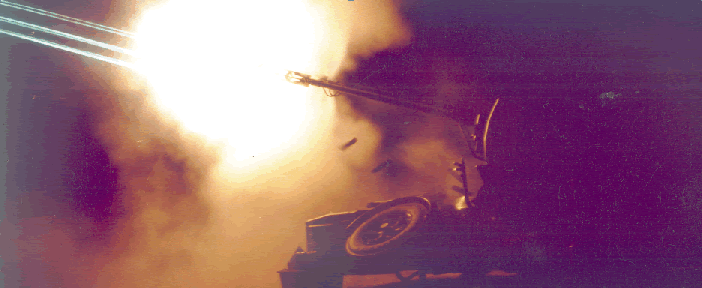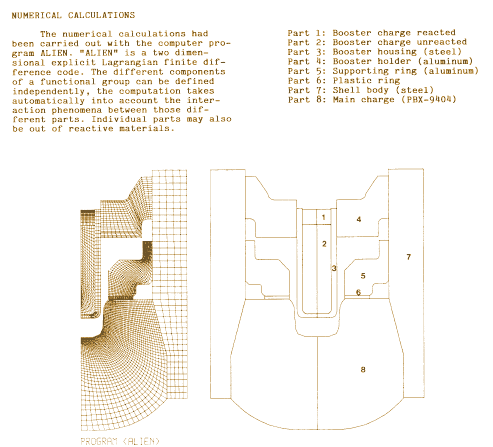


The problem illustrated below shows the starting point of a calculation that makes use of all of these abilities while analyzing 35 mm air-defence shell. It was part of a project that was presented by the developer at the 8th Symposium on Detonation in Albuquerque in 1985
.
The program was later transferred to modern equipment and is still fascinating today. L&G Software still uses it as a valuable tool for examining problems where high pressure and/or explosives play a roll. This program is equivalent to the corresponding newest three-dimensional codes and delivers the same results wherever planes or geometric shapes that are symmetrical around the rotational axis are involved.
Everything began with 'ALIEN' ...
While working as a physicist at Oerlikon Bührle AG in Zurich (as the company “Oerlikon Contraves Pyrotec” was still called in those days) Fritz Leibundgut developed a program called ALIEN for the examination of problems related to weapon- and ordnance technology. The name was chosen in recognition of a science fiction film that was playing in the cinemas at that time, in the 1980s. The code was also named this way to announce that it wasn’t an American one but rather an “alien,” from another world and to be taken seriously. ALIEN is a 2-dimensional finite differences program based on the so-called Lagrange formulas. The code allows the simulation of problems that take the form of either two-dimensional planes or three-dimensional systems that are symmetrical around the rotational axis. This code was originally developed on a digital VAX 11-780 machine, which was accessed through the then usual VT-100 terminal. With the ALIEN program, you can simulate problems such as :
The ALIEN code contains:
Reaction models for explosives, like, for example, the “Forest Fire Burn Model.” This model allows to the user to investigate whether a certain explosive reacts under certain conditions – that is, under the strains that arise during a simulation – and how the explosion proceeds.
The software has a collection of different equations of state for all important materials and explosives, such as, for example, the "HOM equation of state" for metals, solid explosives as well as their reaction products. Here, equations of state that are valid in very high pressures in the MBar range are important. These are strains that arise in explosives and metals connected with explosives.
There are all the necessary contact- and interaction mechanisms needed to automatically calculate the continual collision process, taking into account the individual constraints affecting the different masses or materials.

